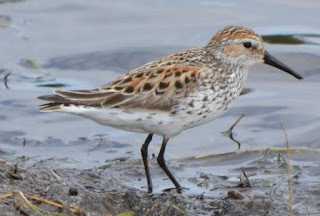Appearance:
- Small sandpiper
- Moderately long bill, thinner at tip than at base, with slight droop
- Black legs
- White underparts
- Thin, white wing stripe
- Black line on rump extends onto tail
Adult:
- Indistinct white supercilium
- Rufous scapulars, crown and cheek (breeding plumage)
- Black back feathers and wing coverts with white edges
- Much black streaking and spotting on breast
- Black chevrons on flanks
- Indistinct gray crown and pale supercilium
- Rufous scapulars
- Black-based back feathers and wing coverts with white and gray edges
- Faint, partial gray breast band
 |
| Western Sandpipers (back) / Least Sandpiper (front) |
This bird is very similar in appearance to yesterday's bird of the day. However, when seen together, the Western Sandpiper is slightly larger than the Least Sandpiper. The longer bill and dark legs also set these birds apart.
Learn more about the Western Sandpiper. 
No comments:
Post a Comment